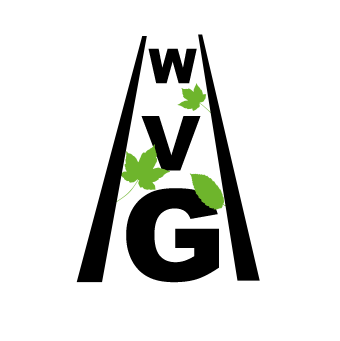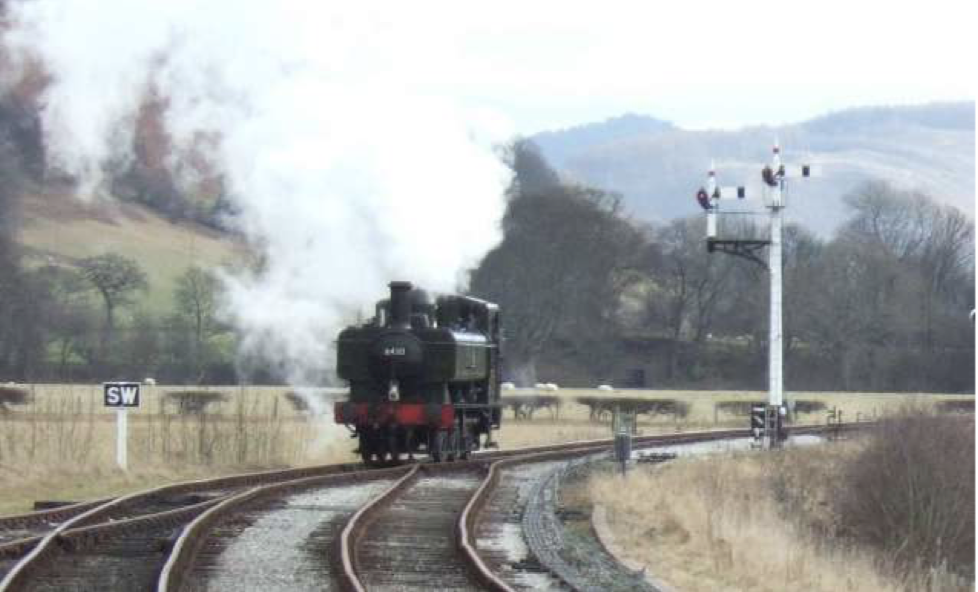History of the Wye Valley Railway
Steam locomotives, autocoaches and diesels
This part describes locomotives classes that are understood to have worked on the Wye Valley Railway line.
Steam Locomotives
Introduction
GWR Coat of Arms
(Hugh Llewelyn CC BY-SA 2.0)
Prior to nationalisation in 1948 the railway companies designed and built their own steam locomotives. The Great Western Railway locomotives were built at their Swindon works which, at its height, employed around 14,000 people.
Locomotive descriptions include a series of numbers that define the wheel arrangement from front to back, for example, 0-6-2 means that there are no non-driven leading wheels at the front of the locomotive, followed by 6 driven wheels and finally 2 non-driven trailing wheels.
On the Great Western Region pannier tank engines were deployed in large numbers. In these locomotives the water tanks for supplying the boiler are arranged on the side of the locomotive in a similar way to panniers on a mule. The abbreviation PT was applied in these cases, so a 0-6-0 PT is a locomotive with 6 driving wheels and no other wheels which is equipped with pannier tanks.
0-6-0 ST No 1048 overturned at Redbrook 16
February 1880
(Railway Magazine)
Tank engines can run equally fast in both directions. However, the engine still needs to be at the front of the train to avoid the view forward being impeded by the coaches or wagons. To achieve this the locomotive has to ‘run-round’ via a passing loop then recoupling for a return journey.
The abbreviation ST denoted ‘saddle tank’ where the tank straddles the locomotive. ‘T’ denotes a side tank locomotive that is shorter than a pannier tank which extends the full length of the locomotive.
The tank engines carried coal in a bunker behind the cab whereas in locomotives that ran for longer distances a separate tender would carry the fuel.
For more information on tank engines click here.
The Lakeside and Haverthwaite Railway provides a simplified description of steam locomotive operation, click here for more information.
GWR saddle tank locomotives
GWR 1363 saddle tank preserved at Didcot Railway Centre
(davidmichaelroch CC BY- SA 2.0)
Saddle tank locomotives preceded other tank locomotives. When more efficient boilers, which were not cylindrical, were introduced an alternative design of tank was required. The 0-6-0 ST class ran on the Wye Valley Railway. 266 were built between 1870 and 1871.
The overturned locomotive No 1048, in the photograph under the Introduction at the start of this section on steam locomotives, is a saddle tank locomotive designed by Joseph Armstrong and built in 1870 at the Great Western Stafford Road Works in Wolverhampton. It survived the incident and, once repaired, continued in service until 1930 when it was scrapped.
Class 455 also called 'Metro' tanks.
140 of these 2-4-0 T were bult for the GWR, originally for their London surburban services, including running on the underground section of the Metropolitan Railway, the source of their nickname. Later on the class was seen in many parts of the GWR system. 80 were bult at the Swindon Railway Works between 1869 and 1899. They were withdrawn between 1900 and 1949. The designer was Joseph Armstrong, the GWR Locomotive, Carriage and Wagon Superintendent.
'Metro' Class 455 No 469 built in 1869 and probably withdrawn shortly after this photograph, dated circa 1912. The location, in Tintern station, which can be identified from the water tower on the right of the photograph.
(Real Photographs)
Joseph Armstrong
Class 5700 0-6-0 PT
This class was built between 1929 and 1950 mostly at the Swindon Works. It was designed by Charles B Collett the Chief Engineer at Swindon. 863 were built making it the most prolific of the GWR locomotives. It weighed 47 1⁄2 tonnes. It was the most powerful of the steam engines in regular use on the line. 16 are preserved.
No 5775 starred in The Railway Children.
Pannier 4612 in preservation at the Bodmin and Wenford railway.
(ahisgett CC BY 2.0)
Pannier 4612 on the ‘Y Glyn Crwydryn’ (The Valley Wanderer) special awaiting right of way at Pontardawe. Summer 1965 .
(Hugh Llewelyn CC BY-SA 2.0)
Class 6400 0-6-0 PT.
This class 6400 was designed by Charles B Collett and built by the GWR between 1932 and 1937.
Numbers 6400, 6412, 6430 and 6439 ran on the Wye Valley Railway of which 6412 and 6430 are preserved. The locomotive weighed 45 tonnes. 40 were built. It was more powerful than Class 1400 that also ran on the line.
6400
6400 at Laira shed, Plymouth
(Lens of Sutton)
Gradient post near Tintern, photograph taken in 1979
(B M Handley)
6412
This locomotive was the star of the 1977/78 children’s TV series, The Flockton Flyer. It has been preserved.
6412 on the WVR – probably at Monmouth as second engine on the last train
(Great Western Trust)
6412 0-6-0 Pannier preserved at Staverton
(Thirty Seven 401 CC BY-NC-ND 2.0)
6430
Evidence that 6340 ran on the WVR comes from a photograph at Tintern that was included in the Railway Magazine of February 1959. It was built March 1937 at Swindon Works and withdrawn from British Railways service in 1964.
The photos below show 6430 in service after the WVR line had closed to passenger traffic as well as in preservation at Llangollen.
6430 at March Mills 29/12/1962
(Lens of Sutton-Peter Gray)
6430 preserved at Llangollen
(john_j_Hudson CC BY-NC-ND2.0)
6430 Llangollen
(john_j_Hudson CC BY-NC- ND2.0)
The remains of a mileage post still in place between Tidenham tunnel and Tintern April
2021
(Martin Scott)
6439
6439 leaving Redbrook station: 0-6-0 PT Collett class
(Peter Brabham)
6439 Last Train Monmouth to Chepstow 4 January 1959 at Monmouth Troy
(Great Western Trust)
Class 1400 0-4-2 T
1400 Class 0-4-2T Collett No. 1421 near
Netherhope. Photo taken circa 1957-58.
(Neil Parkhouse collection)
This class was designed by Charles Collett and built by the Great Western Railway at Swindon for branch line passenger work. 75 were produced between 1932 and 1936. They were popular for light branch line work. The weight of the locomotive was 41.3 tonnes. They were all withdrawn from service by 1964. Four are preserved.
1466 is a class 1400 locomotive preserved at Didcot Railway Centre.
1466 at Didcot Railway Centre in GWR style Brunswick green
(R-P- M CC BY-Nc-Nd 2.0)
1466 at GWR STEAM museum Swindon in post 1948 BR livery and the Lion and Wheel logo which was in use up to 1956
(Shand 1010 CC NC-ND2.0)
Class 2301 and also known as Dean Goods Class. 0-6-0 tender locomotive.
Designed by William Dean. 54 were built. No 2538 was the last to be withdrawn from service in May 1957. One locomotive, 2516 survives and is preserved at the GWR STEAM museum at Swindon.
There is no certainty that the Dean Goods ran on the Wye Valley Railway but exchanges on Facebook have indicated that it could have worked the quarry traffic so it has been included.
2538 0-6-0 Tender Engine
(Lens of Sutton)
2516 in GWR unlined green livery
(Martin Scott)
2516 cab. The driver looking ahead with his hand on the regulator ready to adjust the power
(Martin Scott)
2516 Built at Swindon works in 1897. Withdrawn 1956.
In post 1948 BR livery.
(Gillet's crossing CC BY-NC-SA)
GWR Autocoach (or auto-trailer)
The GWR Autocoach (or auto-trailer) is a type of coach that was used by the Great Western Railway for push-pull trains powered by a steam locomotive. The autocoach is equipped with a driving cab at one end. This allows the driver to control the train without being in the cab of the locomotive. This eliminates the need to run the engine round to the other end of the coach at the end of each journey as well as the need for a passing loop. W153W, W174W and W237W were regularly scheduled turns of duty along the Wye Valley Line towards the end of the 1950’s.
North bound auto-train being loaded with boxes and baskets
(Great Western Trust)
Autocoach 190 preserved at Didcot Railway Centre
(Chowells at English Wikipedia CC BY-SA-3.0)
The driver can also warn of the train's approach using a large mechanical gong, prominently mounted high on the cab end of the autocoach, which is operated by stamping on a pedal on the floor of the cab. The driver, guard and fireman communicate with each other by an electric bell system.
The design proved long-lived with 163 examples being built to a similar design. The last coaches were built in 1954. (Wikipedia and B M Handley)
Diesel Engines
Hymek – Class 35
After passenger, parcels and goods traffic ceased on the line in 1964 the remaining rail activity served the two quarries at Tintern and Tidenham. This quarry traffic lasted for nearly 30 years.
British Railways stopped using steam-hauled trains in 1968 and diesel engines took over. Diesel-hydraulic (Hymek) locomotives were developed for the Great Western Railways and regularly hauled loaded ballast wagons from the quarries. A late change to the livery was the introduction of full yellow warning panels at each end.
Diesel-hydraulic (Hymek) hauling loaded wagons from Tintern Quarry.
(Bill Potter/Kidderminster Railway Museum)
First class Rail tour ticket stopping at Tintern quarry 15 March 1980
(Martin Scott)
Class 37
Class 37 is a diesel-electric locomotive. 309 were produced as part of the British Railways modernisation plan between 1960 and 1965. They weighed 100 tonnes. One of their nicknames was Growler. They operated passenger and freight trains.
A Class 37 emerging from Hillfield crossing before reaching Newport station. The train is 7B07 Newport to Tidenham quarry with a load consisting of ZEV and ZFV ‘Catfish’ and ’Dogfish’ engineers ballast hoppers.
(Adrian Nicholls)
Class 14
Class 14 locomotives served Tidenham Quarry up to the Summer of 1967 as shown in this operating diagram posted on the railway modellers website.
They were also seen working on the line by Martin Scott, one of the Greenways and cycleways volunteers.
They were a type of small diesel- hydraulic locomotive built in the mid- 1960s mostly at the Swindon works. Originally all of them were allocated to the Western Region of British Railways. The anticipated work for this class included short-distance freight trains such as the Tintern quarry traffic.
They were known as ‘Teddy Bears’ by enthusiasts, following a comment by Swindon Works’ erecting shop foreman George Coles who quipped ‘’We’ve built The Great Bear (a GWR iconic 4-6-2 steam engine built in 1908 weighing 142 tons) now we are going to build a ‘Teddy Bear’!’’ (Wikipedia)
Class 14 'Teddy Bear' D 9526 in preservation
at West Somerset Steam Railway.
(Pete Edgeler CC BY-NC-Nd 2.0)
Class 14 D 9516 preserved at Didcot railway centre
(Thirty Seven 401 CC BY-NC-2.0 23 June 2015)
































